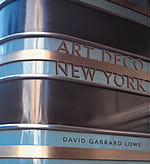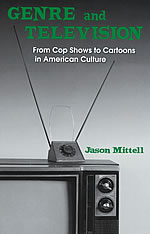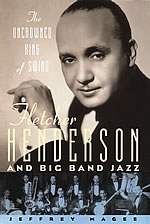|
Issue Contents :: Bookshelf :: Page [ 1 2 ]

Art Deco New York
By David Garrard Lowe ’55
Watson-Guptill Publications, 2004
Lowe, an architectural writer and cultural historian, describes how the Art Deco style of the 1920s and ’30s influenced not only the architecture of New York, but also textiles, graphics, fashion, and furniture. Along with hundreds of photographs of skyscrapers, living rooms, clothing, and cars, Lowe’s study of politics and society helps explain why Art Deco became the symbol of modernity for generations of New Yorkers.
Voices of a People’s History
of the United States
By Howard Zinn and Anthony Arnove ’91
Seven Stories Press, 2004
In this sequel to A People’s History of the United States, the authors offer a look at American history—from Columbus’ discovery of America to President Bush’s war on terror—that is often ignored in history books: those views ex-pressed by dissenters and the disenfranchised in their speeches, letters, poems, and songs. In his introduction to the text, Zinn says: “I want to point out that people who seem to have no power, whether working people, people of color, or women—once they organize and protest and create movements—have a voice that no government can suppress.”
A Trip to Salto
By Circe Maia, Translated by
Stephanie Anderson Stewart ’92
Swan Isle Press, 2004
A mother and her young daughter are trying desperately to catch a train in Uruguay that is transferring their husband and father, a physician and political prisoner, to a prison in Salto. This is the true story of poet Circe Maia, whose series of diary entries from 1972 through 1974 speak of the family’s struggle to cope with daily life under a long separation caused by a totalitarian regime. First published in Uruguay in 1987, the story is presented here in its original Spanish form and in Stewart’s English translation.
Black Life on the Mississippi: Slaves, Free Blacks, and the Western Steamboat World
By Thomas C. Buchanan ’89
The University of North Carolina Press, 2004
Here is the untold story of the slaves and free blacks who worked aboard steamboats on the Mississippi River in the 19th century. By devising ways to link riverside towns in the North and South, workers used the river to communicate with family members, help slaves escape, transfer stolen goods, and otherwise develop their own vibrant culture.
 Genre and Television: From Cop Shows to Cartoons in American Culture Genre and Television: From Cop Shows to Cartoons in American Culture
By Jason Mittell ’92
Routledge, 2004
Mittell, an assistant professor of film and media studies at Middlebury College, offers a new approach to exploring television genres: as cultural categories used by TV industries and audiences. Drawing on such shows as Dragnet and The Simpsons, as well as trends ranging from reality TV to around-the-clock cartoon channels, Mittell explains why genre matters to TV creators, critics, and fans.
Wisdom for a Livable Planet
By Carl McDaniel ’64
Trinity University Press, 2005
McDaniel profiles eight pathbreakers who have devoted their lives to environmental issues, including Oberlin’s David Orr, who spearheaded the Center for Environmental Studies, and Terri Swearingen, a nurse and mother who took on one of the world’s largest hazardous waste incinerators next door to an elementary school. Each of their stories proves that a single person can work successfully to improve conditions on our planet; taken together, they offer a blueprint for further action.
 The Uncrowned King of Swing:
Fletcher Henderson and Big Band Jazz The Uncrowned King of Swing:
Fletcher Henderson and Big Band Jazz
By Jeffrey Magee ’83
Oxford University Press, 2005
While Benny Goodman is praised as the major force behind the Big Band sound, Fletcher Henderson was equally important in “building the kingdom of swing,” argues Magee. Henderson arranged the music that powered Benny Goodman’s rise to success and helped launch the careers of Louis Armstrong and Coleman Hawkins. Drawing on sound recordings, obscure stock arrangements, and hundreds of scores, Magee details the late musician’s personal history and contributions to jazz.
Also Noted:
Near Occasions of
Sin: Poetry
Stuart Friebert, Emeritus Professor of Creative Writing
Doom-Ah Books, 2004
How to Make Dances in an Epidemic: Tracking Choreography in the Age of AIDS
David Gere ’79
Univ. of Wisconsin Press, 2004
Combining Two Cultures: McMaster University’s Arts and Science Programme
Ed.: Herb Jenkins ’48 et al
University Press of America, 2004
Memory and the Impact
of Political Transformation
in Public Space
Ed.: Lisa Maya Knauer ’77 et al
Duke Univ. Press, 2004
Objects of American Art Education: Highlights from the Diana Korzenik Collection
Diana Korzenik ’61
Huntington Library Press, 2004
Principles of
Community Psychology
David Perkins ’72 et al
Oxford Univ. Press, 2005
Tactics of the Crescent Moon: Militant Muslim Combat Methods
H. John Poole ’64
Posterity Press, 2004
Tween Prayer:
Friendship with God
Nancy Roth ’58
Church Publishing, 2004
Memories of Lac du Flambeau Elders
Ed.: Elizabeth Tornes ’77
Univ. of Wisconsin Press, 2004
|





